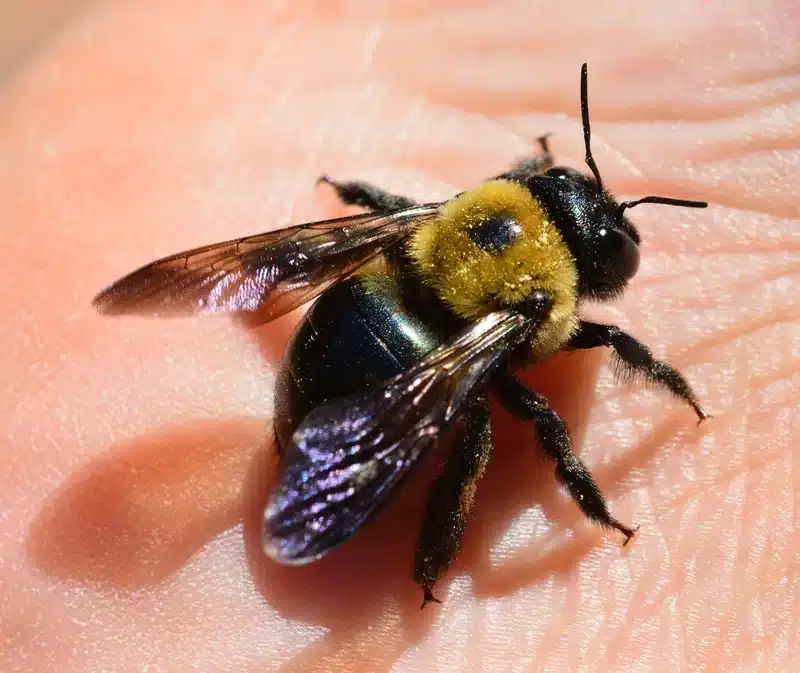If you’ve spotted large, buzzing insects around your home, you might be wondering whether you’re dealing with bumblebees or carpenter bees. While both are important pollinators, only one poses a real threat to your wooden structures.
Bumblebees are the fuzzy friends you want to protect. They nest underground and focus on flowers, not your deck. Carpenter bees, however, are the shiny-bodied insects that drill perfectly round holes into your home’s wood trim, fascia, and railings.
After four years as a registered technician, I’ve inspected countless suspicious holes and sawdust piles around DMV homes. Most homeowners are surprised to learn that the difference between these two insects can mean the difference between admiring beneficial pollinators and dealing with expensive structural repairs. Let me walk you through exactly how to tell them apart and what you need to do about carpenter bee damage.
What Are Bumble Bees and Carpenter Bees: Understanding These Pollinators
Both bumblebees and carpenter bees belong to the same family of insects but lead completely different lives. Bumblebees are social insects that work together in colonies, much like honey bees, while carpenter bees are solitary creatures that work alone.
The bumblebee vs carpenter bee distinction matters because their behavior affects your home differently. Bumblebees build their nests in abandoned rodent burrows or other ground cavities. Carpenter bees, on the other hand, create their own wooden nurseries by boring directly into your home’s exterior.
Both insects are excellent pollinators that perform buzz-pollination - a special technique that tomatoes, eggplants, and blueberries need to produce fruit. This makes them valuable to our local ecosystem, but it doesn’t mean you should ignore structural damage.
The Difference Between Carpenter Bees and Bumblebees: Species in the DMV Area
In the Virginia, Maryland, and DC region, you’ll most commonly encounter the Common Eastern Bumble Bee (Bombus impatiens). These insects are essential for suburban gardens and commercial greenhouse operations. According to Virginia Cooperative Extension, about 14 different bumble bee species have been recorded in Virginia alone.
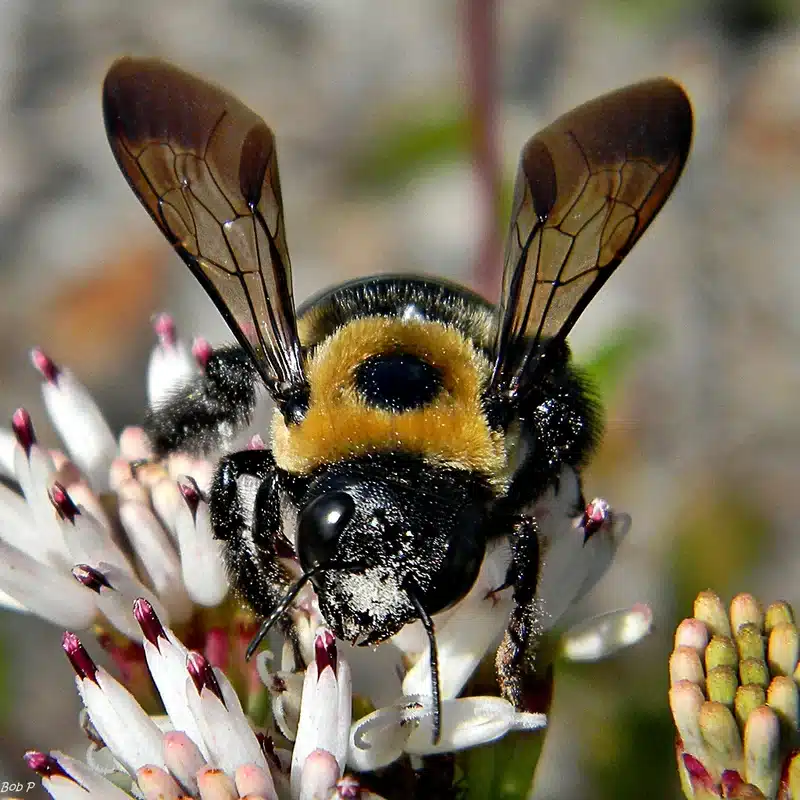
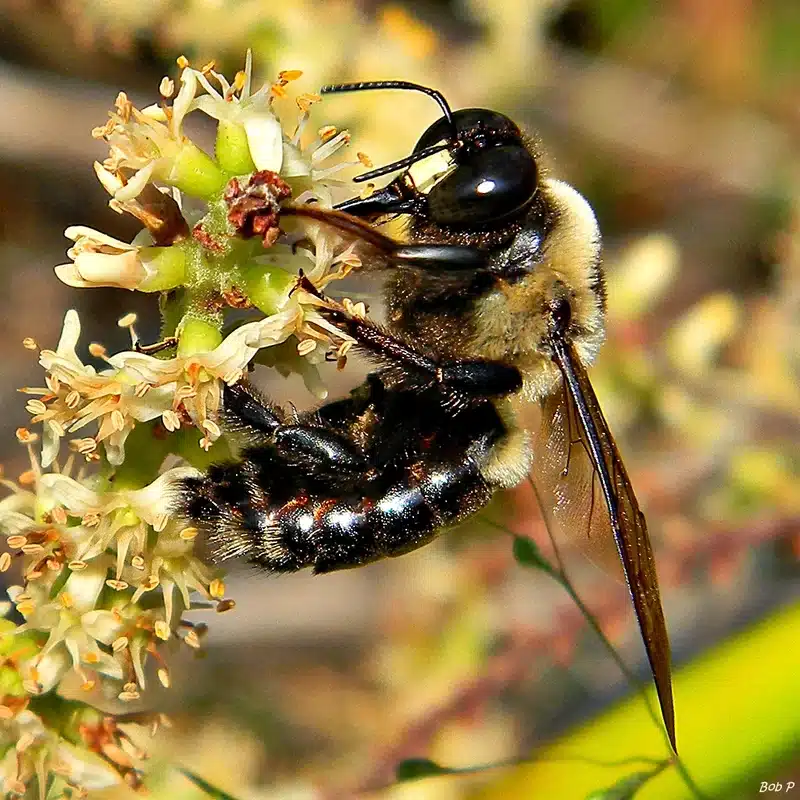
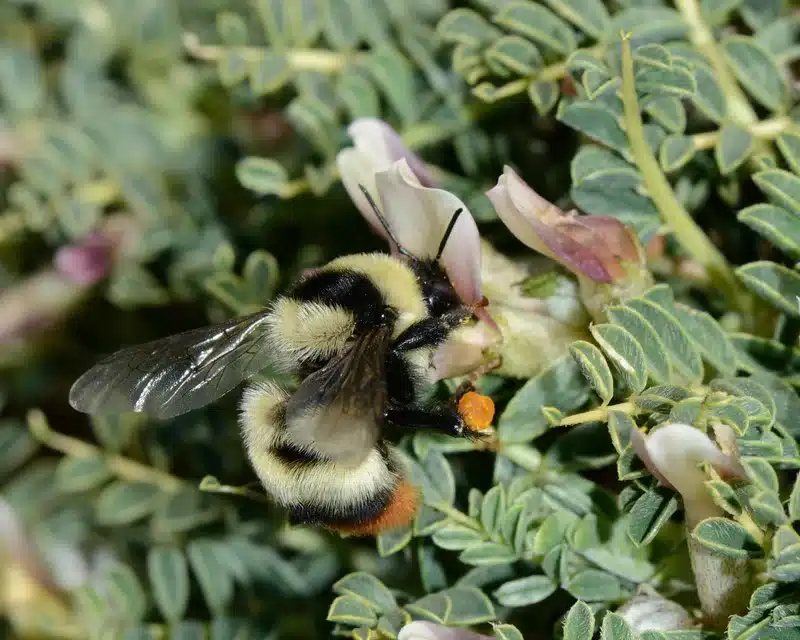
For carpenter bees, the Eastern Carpenter Bee (Xylocopa virginica) dominates our area. This species has adapted well to suburban environments where wooden structures provide plenty of nesting opportunities. You might also spot Xylocopa micans in southeastern Virginia.
The bumblebee vs carpenter bee identification becomes crucial because these species overlap in their active seasons. Both emerge in early spring when homeowners start spending more time outdoors and noticing unusual insect activity.
Key Physical Differences Between Every Kind of Bee: Bumblebees and Carpenter Bees
Abdomen Hair: The Most Obvious Difference
The easiest way to distinguish bumblebee vs carpenter bee is by looking at their abdomens. Bumblebees have densely fuzzy, hair-covered abdomens with yellow and black stripes. Some species also show orange markings.
Carpenter bees have completely hairless, shiny black abdomens that look almost metallic. This smooth surface reflects light, making them appear polished. Once you see this difference, you’ll never confuse the two again.
Facial Markings and Gender Differences
Male carpenter bees sport a distinctive cream or yellow facial marking that looks like a blaze. These males cannot sting but will hover aggressively around their nests to scare away intruders. Female carpenter bees have all-black faces and can deliver a painful sting if handled.
Bumblebee faces vary less dramatically between genders. Both males and females can sting, though they rarely do unless their nest is directly threatened.
Flight Patterns That Give Them Away
Carpenter bee males patrol their territory with distinctive hovering and darting flights. They’ll often “dive-bomb” toward people or pets near their nesting sites, creating the dramatic encounters that lead to service calls.
Bumblebees fly purposefully between flowers and their nests. They don’t waste energy on territorial displays and generally ignore human activity unless you’re blocking their flight path.
Nesting Habits: Bumblebee vs Carpenter Bee Behavior
Social Colonies vs Solitary Living
Bumblebees create annual social colonies that peak at 200-400 workers during midsummer. Queens emerge each spring, establish underground nests in places like abandoned mouse burrows, and build their colonies throughout the season. By fall, only newly mated queens survive to start the cycle again.
Carpenter bees live completely different lives. They’re solitary insects, though you might see several working the same area. Each female creates her own individual nest by drilling into wood.
Where They Choose to Nest
The bumblebee vs carpenter bee nesting preferences explain why only one damages homes. Bumblebees seek out underground cavities, wall voids, or dense vegetation. They essentially recycle existing spaces.
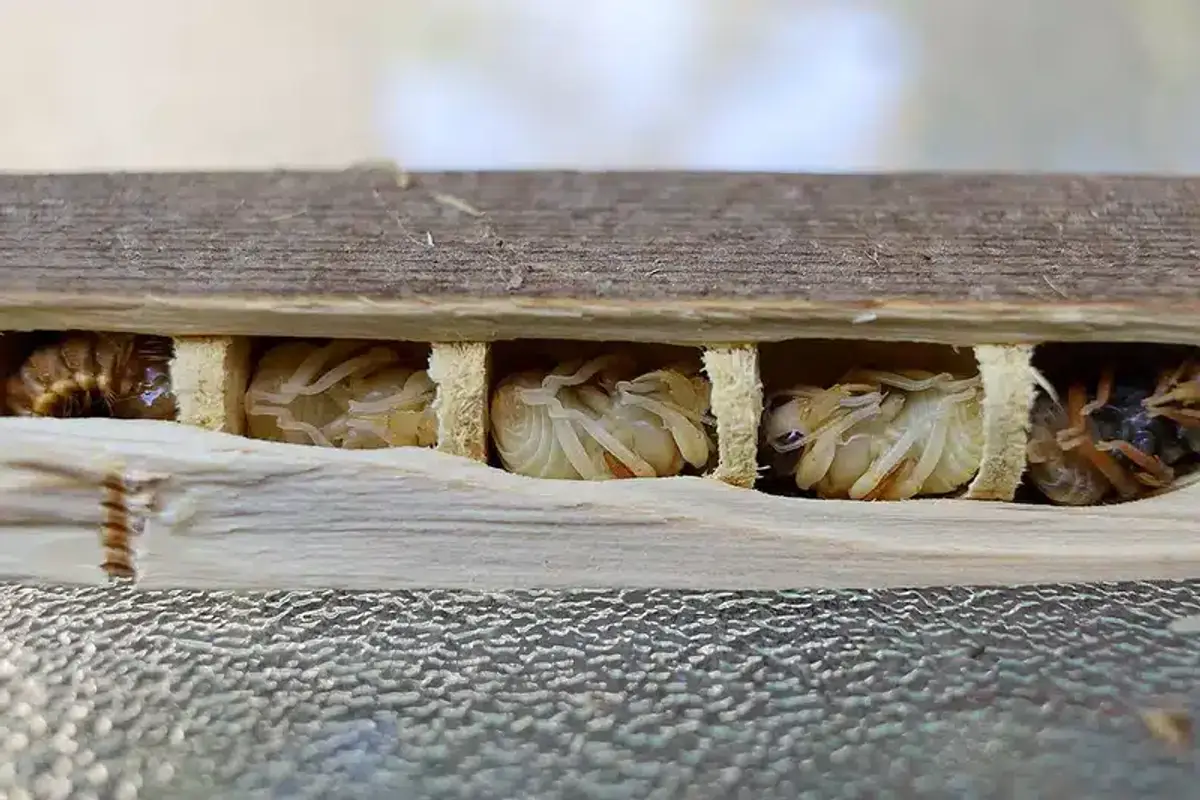
Carpenter bees create their own spaces by boring into bare, unpainted softwood. They target fascia boards, deck rails, pergolas, and outdoor furniture. Painted or pressure-treated lumber rarely gets attacked, which tells us a lot about prevention strategies.
Recognizing Carpenter Bee Damage Signs
During spring inspections, I look for four telltale signs of carpenter bee activity. Perfect circular holes measuring about half an inch across are the most obvious indicator. These holes look like someone used a drill bit - because essentially, that’s what happened.
Coarse sawdust piles directly below the holes appear during active boring season. Fresh sawdust means current activity, while old piles suggest previous seasons’ work. Yellow-brown staining beneath holes comes from the bees’ waste products and creates unsightly fan-shaped marks on siding.
The fourth sign is loud drilling or buzzing sounds from inside hollow wood. Homeowners often describe this as sounding like someone operating a power tool inside their deck posts or trim boards.
These damage patterns never occur with bumblebees, making the bumblebee vs carpenter bee distinction critical for proper treatment decisions.
Long-Term Structural Impact of Carpenter Bees
The real concern with carpenter bees isn’t the initial hole - it’s what happens over multiple seasons. Female carpenter bees often return to extend existing galleries, creating tunnels that can reach 10 feet in length. When several bees target the same area, the cumulative damage weakens structural integrity.
I’ve seen older homes in our service area where years of untreated carpenter bee activity compromised load-bearing trim and fascia boards. Replacement costs for severely damaged boards can run thousands of dollars, especially when you factor in matching materials and painting.
Secondary damage often exceeds the initial boring. Woodpeckers tear apart siding to reach bee larvae inside galleries. Moisture enters through holes, leading to decay fungi and potentially carpenter ant invasions. Each problem builds on the previous one.
How to Get Rid of Bees: Professional Treatment for Carpenter Bee Problems
When structural damage warrants treatment, timing makes all the difference. Late summer or very early spring treatments work best because they target bees without killing active pollinators during peak flower season.
Our registered technicians apply targeted dust treatments directly into gallery openings. Products like deltamethrin dust reach deep into tunnels where sprays can’t penetrate. Surface treatments alone provide less than two weeks of control and don’t address bees already inside galleries.
After treatment, we plug holes with appropriate materials and recommend finishing with paint or sealant. This prevents reinfestations and addresses the conditions that attracted carpenter bees initially. Our approach mirrors successful strategies used for ground bees and other structural pests.
How to Prevent Carpenter Bees: Strategies That Actually Work
Painting exposed wood remains the most effective prevention method. Carpenter bees strongly prefer bare, weathered surfaces and rarely attack painted lumber. Annual maintenance of deck stains and exterior paint creates an effective barrier.
Sealing cracks and filling nail holes eliminates starting points for new galleries. Switching to hardwood materials or vinyl alternatives in high-risk areas provides long-term protection. These prevention methods work better than any chemical treatment for stopping initial infestations.
Regular spring inspections help catch activity early. I recommend homeowners check fascia boards, deck railings, and outdoor furniture each April and May. Early detection allows for targeted treatment before extensive damage occurs.
Protecting Beneficial Bumblebees
Understanding bumblebee vs carpenter bee differences helps protect beneficial species while controlling destructive ones. Leave bumblebee nests completely undisturbed whenever possible. These underground colonies provide excellent pollination services and disappear naturally by fall.
Avoid broad-spectrum sprays on flowering plants where both species might forage. Time any necessary treatments for early morning or evening when bee activity drops. Focus treatments specifically on wood-boring activity, not general bee presence.
This selective approach aligns with integrated pest management principles we use for related insects like paper wasps and yellowjackets. Each species requires different strategies based on their specific behaviors and risks.
Why Choose Better Termite & Pest Control
Our family business has served the DMV area for over 50 years, giving us deep experience with local bee populations. Our registered technicians take your call directly - no phone trees or overseas operators. You’ll speak with someone who understands bumblebee vs carpenter bee issues firsthand.
We’ve eliminated 9 harsh chemicals commonly used in our industry, choosing better alternatives like Essentria and borate-based solutions. Each product passes through our internal research team and meets standards we’d use in our own homes. Our approach balances effective control with environmental responsibility.
No binding contracts mean you can cancel anytime with just 30 days notice. Plus, our unlimited callback policy ensures we keep returning until your carpenter bee problem is completely resolved at no additional cost.
For cost-conscious homeowners, our service pricing guide helps you budget for professional treatment. We also serve specific areas like Arlington with technicians familiar with local construction styles and carpenter bee patterns.
Additionally, customers often benefit from bundled services that address related structural threats like termite prevention and termite removal, especially since moisture problems that attract carpenter bees can also create termite-friendly conditions.
Taking Action Against Carpenter Bee Damage
Don’t wait until extensive damage occurs. Early intervention prevents costly repairs and stops infestations from expanding. Most homeowners underestimate how quickly carpenter bee galleries can compromise structural wood, especially in older homes common throughout our service area.
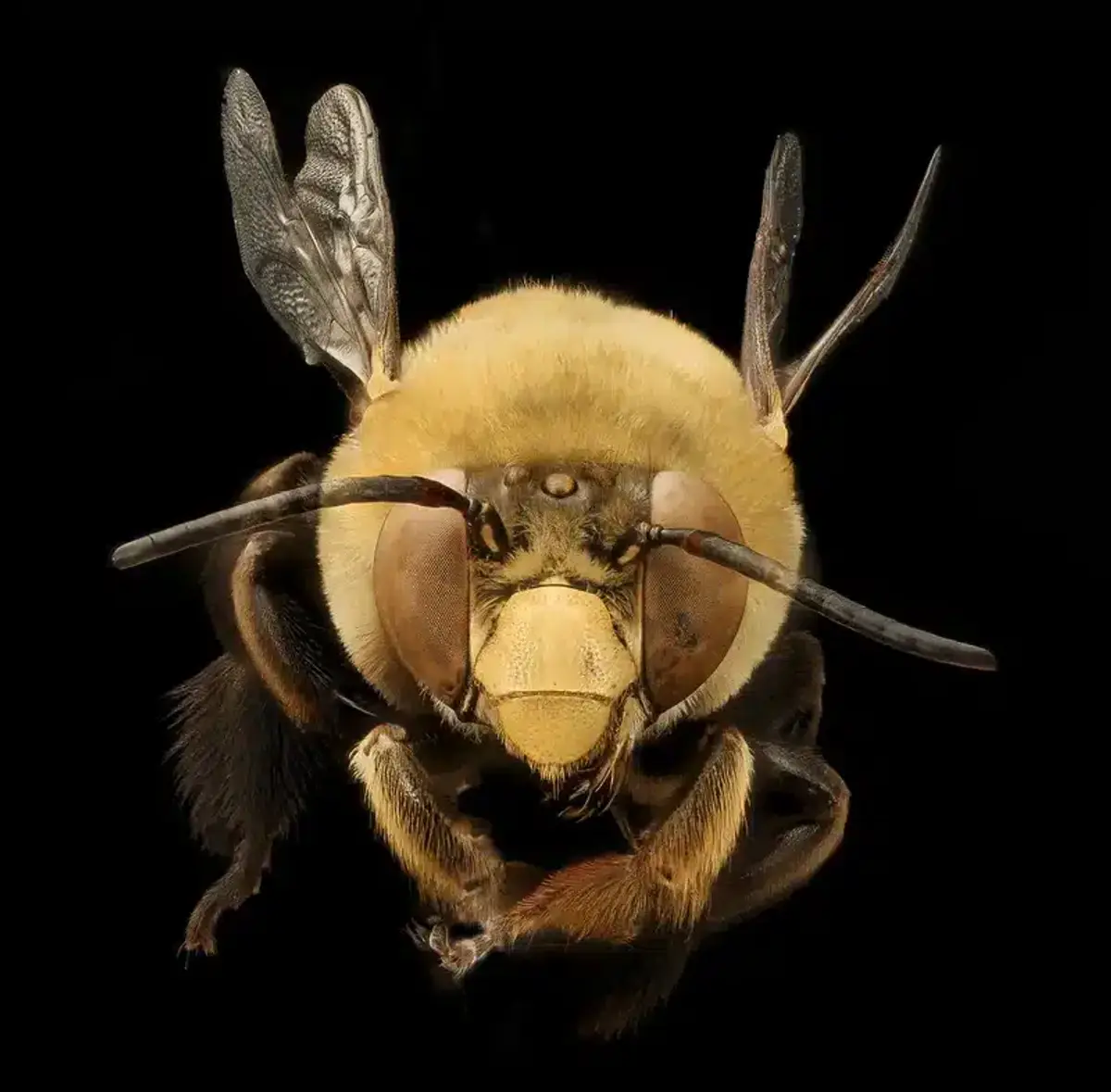
If you’ve spotted the telltale round holes, sawdust piles, or heard drilling sounds, contact our team immediately. Our registered technicians will perform a thorough inspection, identify the extent of activity, and recommend targeted treatments that protect both your home and beneficial pollinators.
Frequently Asked Questions
How can you tell a bumblebee vs carpenter bee at a glance?
+
Look at the abdomen - that's the easiest identifier. Bumblebees have fuzzy, hairy abdomens with yellow and black stripes, while carpenter bees have completely smooth, shiny black abdomens that reflect light. Additionally, carpenter bees are typically larger and more robust than bumblebees.
Do carpenter bees sting and are they dangerous?
+
Female carpenter bees can sting but rarely do unless handled directly. Male carpenter bees cannot sting at all, despite their aggressive hovering behavior around nests. The real danger from carpenter bees comes from structural damage to your home, not from stings.
Will bumblebees damage my wooden deck?
+
No, bumblebees do not damage wooden structures. They nest underground in existing cavities like abandoned rodent burrows or dense vegetation. Bumblebees focus entirely on collecting nectar and pollen from flowers, not boring into wood like carpenter bees do.
What should I do if I find carpenter bee holes in my home?
+
Document the locations and contact a registered pest control technician for inspection. Don't immediately plug the holes, as active galleries need treatment first. Take photos of the holes and any sawdust piles to help professionals assess the extent of activity and plan appropriate treatment.
How much does it cost to treat carpenter bees?
+
Treatment costs vary based on the extent of infestation and number of active galleries. Most carpenter bee treatments include a 30-day warranty, with follow-up visits included if activity continues. Contact our team at 703-683-2000 for a detailed estimate based on your specific situation.
Can I treat carpenter bees myself?
+
While DIY treatments exist, professional treatment ensures complete gallery penetration and proper timing to minimize pollinator impact. Improper treatment timing or application methods often lead to incomplete control, allowing damage to continue. Professional treatments also include prevention recommendations and follow-up monitoring that DIY approaches typically miss.
When are carpenter bees most active during the year?
+
Carpenter bees are most active during spring (April-May) when they emerge from overwintering sites and begin boring new galleries. You'll also see increased activity in late summer when new adults emerge from galleries. Spring activity causes the most noticeable damage, with fresh sawdust and drilling sounds alerting homeowners to problems.
Do painted surfaces really prevent carpenter bee damage?
+
Yes, carpenter bees strongly prefer bare, weathered wood and rarely attack painted surfaces. Regular maintenance of paint and stain finishes provides excellent prevention. However, any exposed wood areas like cut ends of boards or areas where paint has worn away remain vulnerable to attack.
With five years of hands-on experience in the pest control industry, George Schulz is a registered technician with the Virginia Pest Management Association and a proud third-generation professional in a family business that's been protecting homes for over 57 years. He manages and trains a team of service pros while also leading internal research efforts—recently spearheading a deep-dive review of thousands of documents on pest control materials to hand-pick the most kid and pet friendly, most effective solutions tailored specifically for homes in the DC metro area.
